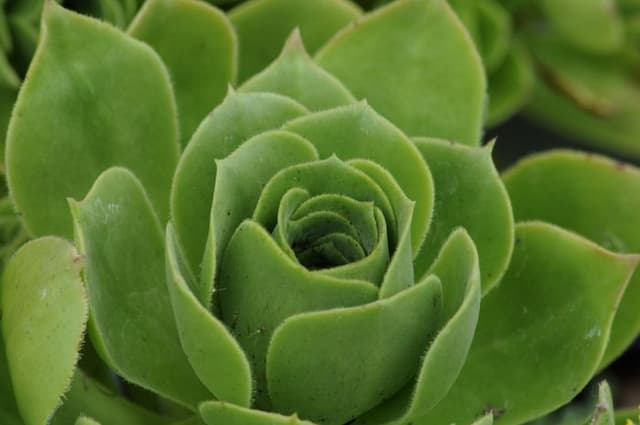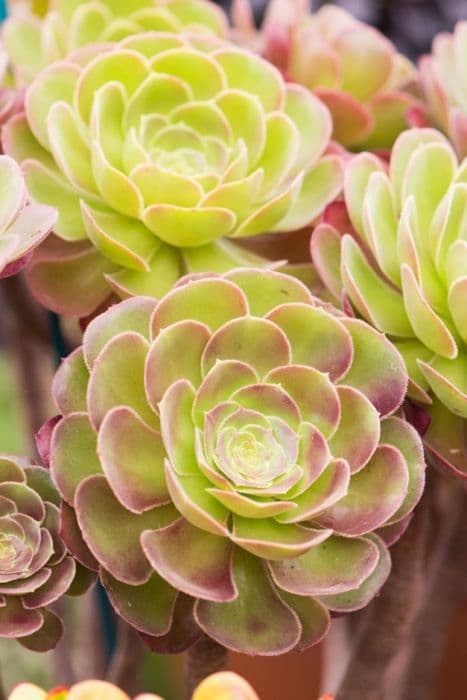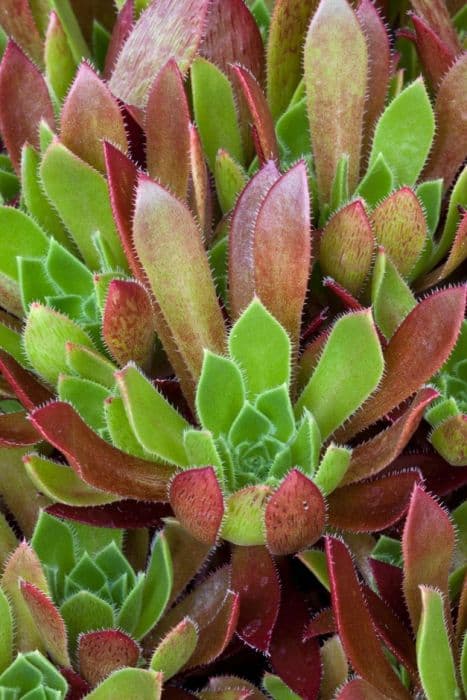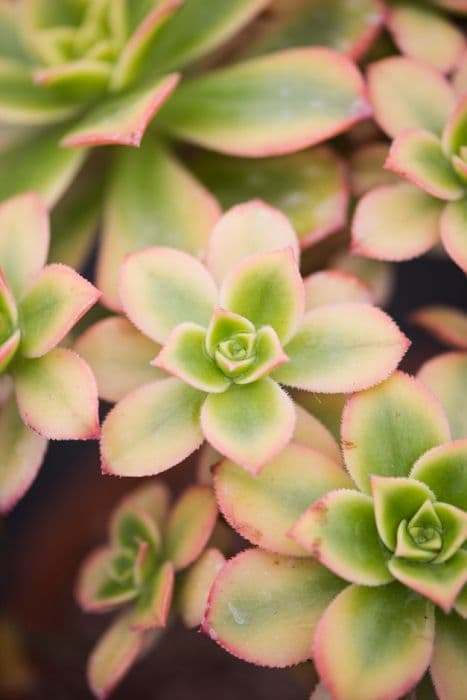Houseleek Sempervivum calcareum 'Guillaumes'

ABOUT
The plant known as the Houseleek displays a stunning array of features, beginning with its rosette formation. The leaves are dense and create a substantial, symmetrical rosette pattern. They have a green base color, which can sometimes appear slightly blue-green, and exhibit red tips that enhance their visual appeal. The thickness of the leaves contributes to the plant's succulent nature—they are fleshy and designed to retain moisture. The texture is also noteworthy, bearing a smooth surface with some species having a slight fuzz or hairiness. As for the blooms, they rise on stalks above the rosette, boasting star-shaped flowers in shades of pink or red, which add a burst of color to the plant's overall muted green palette. These flowering stalks stand out against the foliage, attracting pollinators and adding to the plant's charm. Seasonally, variations in color intensity can be observed, often influenced by the temperature and light conditions. Overall, the Houseleek is a compact and hardy plant, capable of withstanding tough conditions while maintaining its ornamental allure.
About this plant
 Names
NamesFamily
Crassulaceae
Synonyms
Hen And Chicks, Houseleek
Common names
Sempervivum calcareum 'Guillaumes'.
 Toxicity
ToxicityTo humans
Houseleek is generally considered non-toxic to humans. There are no significant reports of poisoning from ingesting this plant. Therefore, consuming houseleek typically does not result in any adverse symptoms for people. However, as with any non-food plant, consuming it in large amounts or for those with particular sensitivities may cause stomach discomfort or other digestive issues.
To pets
Houseleek is also generally considered non-toxic to pets such as cats and dogs. Ingesting this plant should not result in poisoning or serious health issues. While it is not common for pets to consume houseleek, if they do, it is unlikely to cause more than minor stomach upset.
 Characteristics
CharacteristicsLife cycle
Perennials
Foliage type
Evergreen
Color of leaves
Green
Flower color
Pink
Height
0.5 feet (15 cm)
Spread
1 feet (30 cm)
Plant type
Succulent
Hardiness zones
4
Native area
Europe
Benefits
 General Benefits
General Benefits- Drought-tolerant: Sempervivum calcareum 'Guillaumes', commonly known as Hen and Chicks, is highly tolerant of dry conditions once established, making it suitable for water-wise gardens.
- Low maintenance: This plant requires minimal care, making it an excellent choice for busy gardeners or those new to gardening.
- Cold hardy: Hen and Chicks can withstand cold temperatures and even snow, making it suitable for gardens in cooler climates.
- Evergreen: It retains its foliage year-round, adding constant color and texture to the landscape.
- Attractive foliage: The rosettes provide unique geometric shapes, vibrant colors, and interesting textures that enhance garden aesthetics.
- Propagation: It easily propagates from offsets, allowing gardeners to expand their collection or share with friends without purchasing new plants.
- Versatility: Hen and Chicks can be grown in containers, rock gardens, green roofs, and alpine gardens, offering diverse landscaping options.
- Pest resistant: This plant is generally resistant to pests, reducing the need for chemical treatments.
- Groundcover: Its growth habit makes it an excellent groundcover, helping to minimize weeds and soil erosion.
- Rock garden friendly: Its ability to thrive in rocky, well-draining soil makes it ideal for rock gardens and similar environments.
 Medical Properties
Medical PropertiesThis plant is not used for medical purposes.
 Air-purifying Qualities
Air-purifying QualitiesThis plant is not specifically known for air purifying qualities.
 Other Uses
Other Uses- Roof covering: The common name hen and chicks can be used as a living roof covering due to its hardiness and low maintenance, making it ideal for green roofing projects.
- Living mulch: Hen and chicks can act as a sustainable mulch alternative, keeping soil moist and reducing weed growth due to its spreading habit.
- Erosion control: Its ability to root at different points makes hen and chicks effective for stabilizing slopes and preventing soil erosion.
- Decorative patterns: Gardeners can use hen and chicks to create intricate patterns and designs in rock gardens or groundcover areas due to their uniform rosette shapes.
- Photography subjects: Hen and chicks, with their symmetrical form and variety of colors, serve as a popular subject for botanical and macro photography.
- Garden borders: These plants are low-growing and can easily form tidy borders along garden paths or flower beds, highlighting other plantings with their contrasting form.
- Education: Hen and chicks can be used to teach the basics of propagation to students or gardening beginners, as they easily produce offsets.
- Drought-resistant lawn alternative: In regions with water scarcity, hen and chicks can be used to create a low-maintenance, drought-resistant groundcover to replace traditional lawns.
- Craft projects: The rosettes of hen and chicks are commonly used in succulent wreaths or plant art, adding a unique texture and shape to the composition.
- Fairy gardens: These compact plants are ideal for creating whimsical fairy gardens, providing house-like structures for imaginative play or decoration.
Interesting Facts
 Feng Shui
Feng ShuiThe plant Hens and Chicks is not used in Feng Shui practice.
 Zodiac Sign Compitability
Zodiac Sign CompitabilityThe plant Hens and Chicks is not used in astrology practice.
 Plant Symbolism
Plant Symbolism- Resilience and survival: The common name for Sempervivum calcareum 'Guillaumes' is Hen and Chicks, which refers to how it propagates by producing offsets. This makes it a symbol of resilience and survival, as the plant easily proliferates and survives in harsh conditions.
- Protection and safety: Sempervivum in Latin means "live forever," symbolizing protection and safety due to its hardy nature and the belief that it can protect against lightning and fire when grown on rooftops.
- Maternal care and nurturing: As the plant grows "chicks" around the "hen," it can symbolize maternal care and nurturing, representing the way mothers protect and ensure the survival of their offspring.
- Timelessness and endurance: Given its Latin name and reputation for longevity, Hen and Chicks also symbolizes timelessness and endurance, reflecting an entity that withstands the passing of seasons and trends.
- Self-sufficiency: This plant's ability to grow in nutrient-poor soils and its drought tolerance exemplify self-sufficiency and the ability to thrive with minimal resources.
 Water
WaterHen and chicks, the common name for Sempervivum calcareum 'Guillaumes', should be watered sparingly as they are drought-tolerant. It is recommended to water them deeply but infrequently, allowing the soil to dry out completely between watering. During the active growing season in spring and summer, watering once every 7 to 10 days with about one gallon per square foot should suffice. In the fall and winter, reduce watering to once per month, or whenever the soil is completely dry, depending on the humidity and temperature conditions.
 Light
LightHen and chicks prefer full sunlight to partial shade for optimal growth. They should be placed in a location where they can receive at least 6 hours of direct sunlight daily. If indoors, a south or west-facing window is ideal. These succulents can tolerate some shade, but too little light may cause them to stretch and lose their compact shape.
 Temperature
TemperatureHen and chicks are cold-hardy and can tolerate temperatures as low as -20°F, making them suitable for many outdoor environments. They do best in temperatures ranging from 65°F to 75°F, but can survive in temperatures that occasionally dip down to 40°F or peak up to 90°F. They should be protected from extreme cold by providing shelter or mulch over the winter.
 Pruning
PruningHen and chicks may require minimal pruning to remove dead leaves or spent flower stalks. This usually occurs naturally, and dead leaves can be gently pulled away from the base of the plant. Pruning is mostly for aesthetic purposes and to maintain plant health. The best time for pruning is in the spring or after the plant flowers, which is typically in the summer.
 Cleaning
CleaningAs needed
 Soil
SoilHouseleeks prefer a well-draining soil mix with coarse sand or perlite and peat or compost; aim for a pH of around 5.8 to 6.2 for Sempervivum calcareum 'Guillaumes'.
 Repotting
RepottingHouseleeks like Sempervivum calcareum 'Guillaumes' should be repotted every 2-3 years to replenish soil and nutrients.
 Humidity & Misting
Humidity & MistingHouseleeks do not require high humidity; Sempervivum calcareum 'Guillaumes' thrives in dry conditions typical of its alpine habitat.
 Suitable locations
Suitable locationsIndoor
Provide bright light and well-draining soil for indoor Houseleeks.
Outdoor
Plant in full sun to part shade, in gritty, well-draining soil for outdoor Houseleeks.
Hardiness zone
Sempervivum calcareum 'Guillaumes' is suitable for USDA zones 4-8.
 Life cycle
Life cycleSempervivum calcareum 'Guillaumes', commonly known as the 'Guillaumes' Houseleek, begins its life as a small seed, germinating in well-draining soil with plenty of sunlight. After sprouting, it enters a vegetative stage, growing fleshy, rosette-forming leaves and establishing a strong root system. Over time, it matures and forms offshoots or "pups" at the base of the parent rosette, gradually forming a clump of multiple rosettes. Once mature, usually after several years, the central rosette produces a flower stalk with star-shaped, pink or red flowers, indicating the plant has reached its reproductive stage. After flowering, which is often prompted by stress or seasonal change, the monocarpic central rosette dies, leaving behind the pups to continue growing. These pups then repeat the life cycle, eventually growing into mature rosettes that will flower and produce their own offsets.
 Propogation
PropogationPropogation time
Spring-Early Summer
The most popular method of propagation for Sempervivum calcareum 'Guillaumes', commonly known as Hen and Chicks, is through offsets. Hen and Chicks naturally produces small offsets or 'chicks' around the base of the mother plant 'hen'. These can be easily propagated during the growing season, which is spring and early summer. To propagate, gently twist the offset from the mother plant, ensuring it has some roots attached. Allow the offset to dry for a day or two to form a callous over the cut surface. Plant the offset in well-draining soil, watering sparingly until the roots are established. New plants will typically start to grow within a few weeks.









